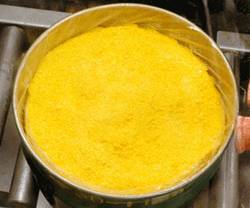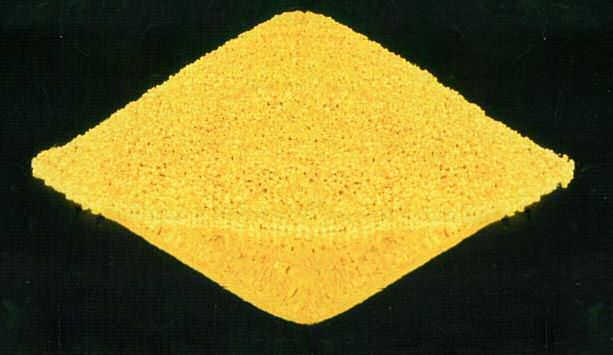Sweet "yellow" Pepper
8/17/10
| Scientific classification | |
|---|---|
| Kingdom: | Plantae |
| (unranked): | Angiosperms |
| (unranked): | Eudicots |
| (unranked): | Asterids |
| Order: | Solanales |
| Family: | Solanaceae |
| Genus: | Capsicum |
| Species: | C. annuum |
| Binomial name | |
Bell pepper or sweet pepper is a cultivar group of the species Capsicum annuum (chili pepper). Cultivars of the plant produce fruits in different colors, including red, yellow and orange. The fruit is also frequently consumed in its unripe form, when the fruit is still green. Bell peppers are sometimes grouped with less pungent pepper varieties as "sweet peppers". Peppers are native to Mexico, Central America and northern South America. Pepper seeds were later carried to Spain in 1493 and from there spread to other European, African and Asian countries. Today, Mexico remains one of the major pepper producers in the world.
Nomenclature
The misleading name "pepper" (pimiento in Spanish) was given by Christopher Columbus upon bringing the plant back to Europe. At that time peppercorns, the fruit of Piper nigrum, an unrelated plant originating from India, were a highly prized condiment; the name "pepper" was at that time applied in Europe to all known spices with a hot and pungent taste and so naturally extended to the newly discovered Capsicum family. The most commonly used alternative name of the plant family, "chili", is of Central American origin. Bell peppers are botanically fruits, but are generally considered in culinary contexts to be vegetables. When cut off, the top of the bell pepper is referred to as a "pepper pan"
While the bell pepper is a member of the Capsicum family, it is the only Capsicum that does not produce capsaicin, chemical that can cause a strong burning sensation when it comes in contact with a lipophilicmucous membranes. The lack of capsaicin in bell peppers is due to a recessive form of a gene that eliminates capsaicin and, consequently, the "hot" taste usually associated with the rest of the Capsicum family.
The term "bell pepper" or "pepper" or "capsicum" is often used for any of the large bell shaped capsicum fruits, regardless of their color. In British English, the fruit is simply referred to as a "pepper", or additionally by colour (as in the term "green pepper", for example), whereas in many Commonwealth of Nations countries, such as Australia, India, Malaysia and New Zealand, they are called "capsicum". Across Europe, the term "paprika", which has its roots in the word for pepper, is used—sometimes referred to by their color (e.g., "groene paprika", "gele paprika", in Dutch, which are green and yellow, respectively). Paprika also refers to the powdered spice made from the fruits in the capsicum family.In France it is called "poivron", with the same root as "poivre" (meaning "pepper"), or "piment". In Japan, the word ピーマン ("pîman" from the French) refers only to green bell peppers, whereas パプリカ ("papurika" from paprika) refers to bell peppers of other colors.
In the Ohio Valley, people sometimes refer to bell peppers as mangos. This has been explained by the practice of pickling the fruit known as a mango when it was imported to the [[Thirteen colonies|American colonies in the 1600s, before refrigeration. At some point any fruit which was pickled was called "mango". Bell peppers were sometimes pickled, so they were called mangos.
| Nutritional value per 100 g (3.5 oz) | |
|---|---|
| Energy | 84 kJ (20 kcal) |
| Carbohydrates | 4.64 g |
| Sugars | 2.40 g |
| Dietary fiber | 1.7 g |
| Fat | 0.17 g |
| Protein | 0.86 g |
| Thiamine (Vit. B1) | 0.057 mg (4%) |
| Riboflavin (Vit. B2) | 0.028 mg (2%) |
| Niacin (Vit. B3) | 0.480 mg (3%) |
| Pantothenic acid (B5) | 0.099 mg (2%) |
| Vitamin B6 | 0.224 mg (17%) |
| Folate (Vit. B9) | 10 μg (3%) |
| Vitamin C | 80.4 mg (134%) |
| Calcium | 10 mg (1%) |
| Iron | 0.34 mg (3%) |
| Magnesium | 10 mg (3%) |
| Phosphorus | 20 mg (3%) |
| Potassium | 175 mg (4%) |
| Zinc | 0.13 mg (1%) |
| Percentages are relative to US recommendations for adults. Source: USDA Nutrient database | |
Yellow flamingos for Lance
7/19/10
When local boy Lance Armstrong won his 7th Tour de France, a local nursury put out all these yellow flamingos in his honor.
this picture by dontmesswithtaxes.typepad.com
Yiruma - From The Yellow Room (2003)
6/20/10
Yiruma is the stage name of I Ru-ma (born February 15, 1978), a South Korean pianist and composer. The name "Yiruma" means accomplishment in Korean.
Yiruma is well-known throughout the world, and his albums are sold all over Asia, as well as the United States and Europe. His best-known pieces are "River Flows in You", "Love Me" both of which appear on the album "First Love" (2001), and "Kiss the Rain" from the album "From The Yellow Room" (2003). He lived in Osaka, Japan, for six years, then entered the Republic of Korea Navy in July 2006 to begin his two-year military service, which is compulsory for all male South Koreans.
From The Yellow Room by Yiruma was actually one of the very first album and artist of New Age music that I have known & heard, its also one of my favorite album of his that made me fall in love with him (I mean his talent). Each track of this album has something to love about, each has there own mood and feelings that the artist has successfully conveyed and I personally love how relaxing and gentle the music in this album sounds. Also in this album, Kiss the Rain, has been part of the movie soundtrack of *Twilight Series with the other song of Yiruma, "River Flows in You" from his other album.
Yellowcake (also called Urania or Uranium)
6/17/10
Yellowcake (also called urania) is a kind of uranium concentrate powder obtained from leach solutions, in an intermediate step in the processing of uranium ores. Yellowcake concentrates are prepared by various extraction and refining methods, depending on the types of ores. Typically yellowcakes are obtained through the milling and chemical processing of uranium ore forming a coarse powder which has a pungent odour, is insoluble in water and contains about 80% uranium oxide, which melts at approximately 2878 °C. Although uranium is one of the densest metals on Earth, yellowcake is relatively light, with a density approximately that of elemental sulfur.
The ore is first crushed to a fine powder by passing raw uranium ore through crushers and grinders to produce "pulped" ore. This is further processed with concentrated acid, alkaline, or peroxide solutions to leach out the uranium. Yellowcake is what remains after drying and filtering. The yellowcake produced by most modern mills is actually brown or black, not yellow; the name comes from the color and texture of the concentrates produced by early mining operations.
Initially, the compounds formed in yellowcakes were not identified; in 1970, the U.S. Bureau of Mines still referred to yellowcakes as the final precipitate formed in the milling process and considered it to be ammonium diuranate or sodium diuranate. The compositions were variable and depended upon the leachant and subsequent precipitating conditions. Among the compounds identified in yellowcakes include: uranyl hydroxide, uranyl sulfate, sodium para-uranate, and uranyl peroxide, along with various uranium oxides. Modern yellowcake typically contains 70 to 90 percent triuranium octoxide (U3O8) by weight. Other oxides such as uranium dioxide (UO2) and uranium trioxide (UO3) exist.

Yellowcake is used in the preparation of uranium fuel for nuclear reactors, for which it is smelted into purified UO2 for use in fuel rods for pressurized heavy-water reactors and other systems that use natural unenriched uranium.
Purified uranium metal (not the uranium oxide) can also be enriched in the isotope U-235. In this process, the uranium is combined with fluorine to form uranium hexafluoride gas (UF6). Next, that undergoes isotope separation through the process of gaseous diffusion, or in a gas centrifuge. This produces either: A. Somewhat enriched uranium containing about four percent U-235 that is suitable for use in large civilian electric-power reactors, or B. Highly-enriched uranium containing 90% or more U-235 that is suitable for use in compact nuclear reactors - usually used to power naval warships and submarines, or in nuclear weapons. However, since the collapse of the Soviet Union, there is a worldwide surplus of highly-enriched uranium, and not much is made anymore. All the large uranium diffusion plants in the United States, the former Soviet Union, and the United Kingdom have been closed, and some of them are being demolished. See the Oak Ridge Gaseous Diffusion Plant or K-25.
Yellowcake is produced by all countries in which uranium ore is mined.






















































